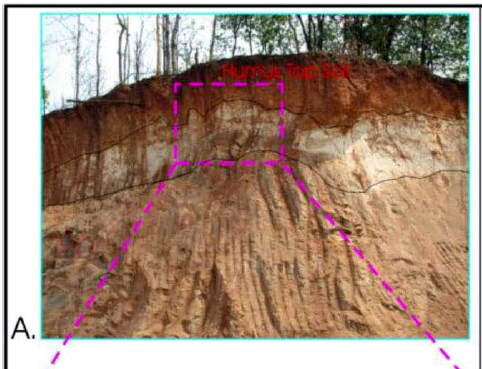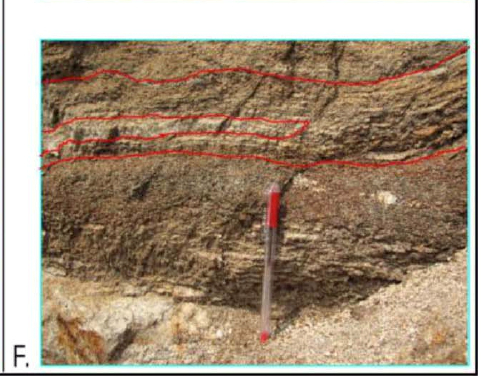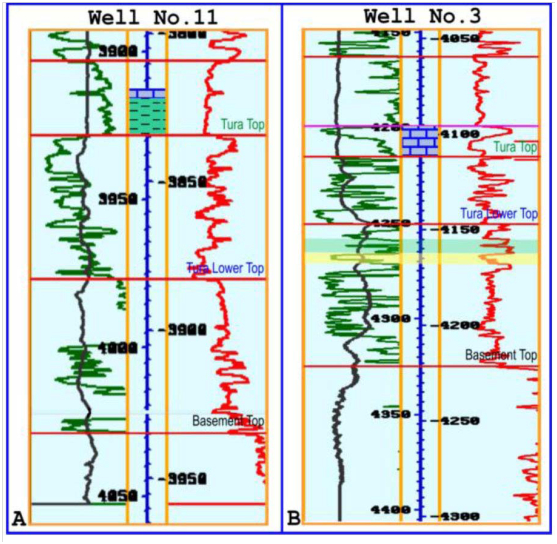Tura Fm
Type Locality and Naming
Lowest formation of Jaintia Gr. Type section is around Tura village in western Garo Hills. Its thickness is 244-500 m in the western Garo Hills. [Original Publication: Fox, C. S. (1937, In Heron). Directorate general Report. Volume 72, pt. 1, pp. 85-90.]. Reference well: Well Teok -1, depth 3566 to 3646 m. Nomenclature and regional use is confusing (see Synonyms)
[Figure 1: Formation stratotypes of North East Basins (modified after Pandey and Dave, 1998)]
Synonyms: Tura Sandstone Fm. While mapping the sedimentary sequence in the western Garo hills, Fox (1937) separated the coal-bearing poorly sorted sandstone, disconformably overlying the Mahadeo rocks or unconformably overlying the basement rocks and named them as ‘Tura sandstone’ after Tura village. Earlier Medlicott (1869) had recognized the clastic sequence exposed around Cherrapunji which was designated as ‘Cherra band’ of Cretaceous age. The Cherra band was found to overlie the Langpars. Ghosh (1940) considered the Cherra sandstone to be a facies equivalent of the lowest limestone-sandstone sequence of Sylhet Limestone Stage of Therriaghat area. Wilson and Metre (1953) included the Lower Therria Limestone and Upper Therria Sandstone substages in their Tura Sandstone. Chandra and Basu (1959) assigned lithostratigraphic status to both Tura and Cherra Formation in Garo and Khasi hills respectively. They have used different stratigraphic ranks for the similar sequence on the plateau (Cherra Fm) and on the southern edge of the plateau (Cherra sandstone member of Therria Formation). Srivastava et al. (1969) have restricted the Cherra sandstone member of Therria Fm and Lakadong Sandstone Member of Sylhet Limestone Formation, with limited success. Chakraborty (1972) while mapping western Khasi and Garo hills introduced ‘Langrin Limestone Member’ within this Tura Formation. Flouria et al., (1969) named the clastic sequence overlying basement and underlying Sylhet limestone in Upper Assam subsurface as Basal Sandstone, whereas the same unit was referred to as Teok Sandstone by Bhandari et al., (1973). Roy and Mukherjee (1976) have correlated the clastic sequence containing coal bands overlying either basement or Mikir Trap Fm and underlying Sylhet Formation in Mikir Hills with Tura Formation of Shilling Plateau. Ranga Rao (1983) referred to this clastic sequence as Tura Sandstone Formation. Deshpande et al., 1993 observed that the terms Tura Fm and Cherra Fm were rather used very loosely, sometime for the same stratigraphic unit or for different stratigraphic units. It has been proposed to use the term Tura Formation for the clastic sequence, which is younger in age than Cherra Fm and occupies an age coeval with the Lakadong Fm Sandstone to Narpuh Fm Sandstone and mostly overlying the basement rocks in southern Shillong Shelf-Mikir Hill and Upper Assam (cf Biswas, 1963); (Pandey and Dave, 1998).
Lithology and Thickness
Sandstone and claystone. Type section lithology: In the type section, a thin conglomerate band having a framework dominated by vein quartz and gneissic pebbles, set in ferruginous and lateritic matrix is present at the base. It passes upwards into thin bedded, loosely cemented, friable mainly quartzose sandstones. Near the top of the sequence there are claystones/shales and occasional coal seams. The claystones are indurated and lithomargic at places, having coal streaks. There are two to three non-persistent coals seams of 1 to 2 m thickness. The coals are often associated with thin stringers of pyrite. Reference section lithology: In the well Teok 1, the lower part of the formation essentially consists of a granite wash with a thin conglomerate band at the base. Upward in the section, the granite wash passes into grit, coarse to medium grained, kaolinitic sandstone and carbonaceous shales.
Two Units are recognized within Tura Formation. They are described at the end.
[Figure 2: Generalized stratigraphy of North Assam Shelf (after Morang and Gupta, 2011)]
[Figure 3: A) Figure showing Kaolinitic clay band with humus top soil and rock materials in transitional stage to form soil towards bottom (after Morang and Gupta, 2011)]
[Figure 4: F) Framework of poorly sorted subangular to subrounded quartz grains showing partial discoloration and discontinuity is filled by iron rich material as micro-laminae (after Morang and Gupta, 2011)]
Relationships and Distribution
Lower contact
Unconformably overlies the Mahadeo Fm in Assam region. Lowest recovered unit in SE Bangladesh drillings.
Upper contact
Conformably overlain by thick limestones of Sylhet Fm.
Regional extent
Garo Hills, Mikir Hills, Dhansiri Valley, Upper Assam Shelf, Nagaland, SE Bangladesh: Typically exposed in west Garo Hills and continues to Shillong Plateau, Mikir Hills, Kopili Valley, Dhansiri Valley and Upper Assam. In SW Bangladesh usage, the formation crops out at Takerghat in the Sylhet district, which is adjacent to the Bangladesh-India border, and has also been reported to be present in the subsurface of Bogra and Rajshahi districts. Partly coeval with Cherra Fm as used in NW Bangladesh. The age assignment of the Cherra Fm as well as that of the Tura Formation, both forming the basal succession of the Cenozoic in the marginal portion of the shelf was long debated. Apart from lithological similarities, the correlation of the microfloral assemblages shows a close correspondence between the two.
GeoJSON
Fossils
Larger foraminifera viz. Miscellanea sp., Nummulites sp. and Discocyclina sp.
Age
Depositional setting
Fluvial deltaic to shallow marine.
Additional Information
MEMBER(S) – Tura Formation has been divided into two parts viz., Tura Lower and Tura Upper, strictly on the basis of log characters.
Tura Upper: Tura Upper unit is a dominantly sandy unit which gradually becomes shaly towards bottom (Figure 3A and Figure 3B). Overall, the sand interbeds invariably show characteristic coarsening log motif with generally high resistivity compared to shale. In the present study, this unit is considered to be the first depositional sequence of the basin in NAS block. Lithologically, the sands of Tura Upper are grey to greenish grey, occasionally whitish grey, medium to coarse grained, at places fine grained to silty, glauconitic, generally calcareous and contain occasional shell fragments while the shales are grey, hard and compact, pyritic with disseminated organic matter and silty lenses. A Conventional core cut in Well-21 (CC-3 Int 3855.48-3863.69) shows presence of whitish to yellowish sandstone, dark grey shale with silty intercalations, burrowing, bioturbation, lenticular and wavy bedding. On the basis of microfauna yield from the same well, Early Eocene age has been assigned to this unit and shallow to marginal marine near shore environment of deposition has been interpreted.
Tura Lower: Tura Lower unit is marked at the top of a highly resistive shale/claystone band. The characteristic high gamma count and resistivity values of this argillaceous band are topped at many wells by a coarsening upward sand sequence (Figure 3A and Figure 3B). In general, sediments of this unit do not show any particular trend on logs. In a few wells like Well-3 and 8 (Figure 1), a sudden increase in the kaolinitic clay content is reported in cutting samples close to top of this unit. Lithologically, Tura Lower unit contains poorly consolidated, whitish grey, light brown to reddish brown, coarse to medium, occasionally very coarse or silty, medium to fine grained, poorly to moderately sorted, angular to sub angular sandstone associated with some thin hard and compact, brownish to whitish, non calcareous, silty kaolinitic to sandy claystone bands (Kataki et al., 2003). Pyrite, leached iron oxide cement and stingers with occasional coal and carbonaceous shale are also reported. Thickness of this unit varies between 40 to 60 m. In most of the wells, this unit is devoid of any fossils and the sediments have been interpreted to be deposited under fluvial/distal alluvial fan depositional environment by earlier workers.
[Figure 5: Representative log section from wells. A - Tura top overlain by thick shale. B - Tura top overlain by limestone bed. High GR with high Rt (Green) and clean GR low Rt (Yellow) relationship. (after Morang and Gupta, 2011)]




